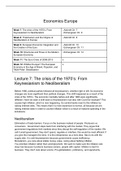Economics Europe
Week 7: The crisis of the 1970’s: From - Aldcroft Ch. 7
Keynesianism to Neoliberalism - Eichengreen Ch. 9
Week 8: Thatcherism and the Origins of - Aldcroft Ch. 8
Neoliberalism in Europe
Week 9: European Economic Integration and - Aldcroft Ch. 10
the Creation of the Euro - Eichengreen Ch. 11
Week 10: Structures and Flows in the Modern - Eichengreen Ch. 12
European Economy
Week 11: The Euro Crisis of 2008-2013 x
Week 12: Whither Europe? The European x
Economy in the Age of Brexit, Populism, and
‘Multi-Polar’ Globalization
Lecture 7: The crisis of the 1970’s: From
Keynesianism to Neoliberalism
Before 1980, political parties followed all keynesianism, whether right or left. So economic
changes are more significant than political changes. This shift happened as a result of the
crisis of the 1970’s. The economic mentality before and after 1980 were significantly
different. Have we seen a shift back to Keynesianism now also with Covid for example? This
causes high inflation, which is now happening. So central banks react to this inflation by
raising interest rates. This means that it is more expensive to borrow, all because we are
raising interest rates in order to counter inflation which is a result of massive spending in the
lockdowns.
Neoliberalism
Elimination of trade barriers. Focus on the business instead of people. Producers vs
consumers. Government steps back from interfering with the market. They argue that
government regulations limit markets since they disrupt the self-regulation of the market. We
call it small government, they don't spend, regulate or interfere, this would be most efficient if
you give the managers the reins. It is the entrepreneur as a hero idea. Has to do with the
supply side. It is anti-keynesianism because governments cause inefficiency.
Monetarism, you care about stable money value, caring about fighting inflation.
You prioritize inflation rather than unemployment. We want to make sure the inflation rate
stays low because it protects business owners, people with capital. Inflation is bad for
business. They don't care about unions. Pro-globalization, proficiency, and opportunity.
,Summary:
- No trade barriers -> free trade
- No borders for the movement of people and products
- Focus on business
- Focus on inflation
- No government intervention
- Monetarism
- Pro-globalization, proficiency and opportunity
- Economic growth but rise of inequality
Keynesianism
Believes in the multiplier effect, if you put money in the economy it will multiply growth. They
don't want to interfere too much but when in a slump the government needs to step in and
countercyclical spending. First time Keynsianist spending in the US at the New Deal?.More
recent example is the Obama spending package 2009. Europeans plead for austerity,
cutting spending. Is pro government. During a downturn the government steps in. Concerned
with full employment rather than inflation. Cares about unions and jobs. Compatible with the
welfare state. Also proved to be very useful in recent crises. Pro government, stimulating the
economy.
Summary:
- Government spending -> countercyclical spending
- Focus on employment, unions and jobs
- Welfare state is important
- Multiplier effect
Globalization
The 80 and the 90s were the heyday of globalization. Globalization goes hand in hand with
free trade and is associated with neoliberalism. Some fundamental ideas of globalization are
free movement of capital and labour, this is all the EU about. This breaks down national
states which they think of as kind of autarky which they see as inefficient. The living standard
in an ideally globalized world converges, the total average is going to be a little higher than
the underdeveloped world. Associated with neoliberalism. Free trade. No trade restrictions.
No borders for people, goods or products.
Demand side economics
Goes hand in hand with Keynesianism. Consumption equals demand. Via fiscal policy.
Focuses on the demand side of macroeconomy, giving people money to spend.
governments make transfer payments. This stimulates businesses and people to spend and
hire more people. More jobs. Fights unemployment.
Supply side economics
How do we create more growth? We care about producers, suppliers. We care about
industry, so the government gives tax cuts to businesses. So they, Thatcher for example,
,privatised industries which should make it more efficient. Businesses say that there are too
many regulations which makes it inefficient. Deregulation is therefore important here to
favour the entrepreneur. Another term for neoliberalism. Suppliers are favored. They
oppose government regulation, taxation. Anti-inflation, lowering costs for businesses. They
can efficiently bring maximum goods to the market. Increase the cost of everything in
society. This can lead to inefficiency, bloating and low productivity. And de-incentivizes
entrepreneurialism. It is concerned with keeping inflation low, because this is also a cost
on business. It is less concerned with unemployment, it is seen as a ‘pro business’ policy
Subject of today's lecture.
● Stagflation, combination of inflation and unemployment thus no growth, crisis of the
1970’s.
● Shift from the age of keynesianism (1935-1980) towards the age of neoliberalism
(1980-2016?).
● The golden age (1950-1970) happened when there was keynesianism, so there is a
debate whether keynesianism was the cause or caused growth. People thought that
neoliberalism was the only way out of the crisis.
● Crisis of the 1970s was unsolvable with Keynesianism, which is why the era ended.
Investment is throwing out money, which makes government spending inefficient.
This however causes more inflation. Neoliberalism came therefore with the solution
of austerity.
Since 1980 the economy grew, so Neoliberalism has gained increasing ground. The EU is
fundamentally an economic policy, it is very much a neoliberal dream. We can't go back to
Keynesianism because it was considered to always lead to stagflation. However under
neoliberalism there was economic growth but inequality has risen. Inequality grows and
middle class security is undermined by factories closing. Globalization eroded middle class
security. By 2010-2016 we saw an increase of middle class voters away from mainstream
political parties, towards fringe parties.
The Golden Age of Capitalism
High growth rates are one aspect of the golden age of capitalism. This is important because
a rise in GDP causes the quality of life to grow. The average person depends on that growth.
Neoliberals assume that this wealth will be distributed evenly. The welfare state comes along
and redistributes wealth from the rich to the middle class. Did Keynesianism cause this
wealth? Probably not? Maybe industrialisation was part of it. It was a time of
unprecedented (and unrepeatable) technological opportunities. Society became ‘electrified’;
meaning that consumers switched their homes to rely on electric appliances. These labour
saving devices had several effects.
Europe moved toward being a one class society -> the end of classism. By the 1960s home
appliances freed women to join the workforce by the 70’s. There is thus more money going
around which adds to GDP. The birth control pill meant that women could marry much later
and could go to university.
, The culture of the 1960s was also very middle class. The hippie culture. ALso during the
60’s and 70’s meant family vacationing. Why did Europe become a one class society? In
other words, how did the majority of households capture so much of the wealth? Mixes of
Keynesianism and neoliberalism.
Why did the middle class increase in wealth?
● Neo classicists will say that it's because of high growth.
● Pikkety says that G was greater than R. R is the rate of return of investment and G is
growth. Piketty : r > g and g > r. We got lucky.
● Keynesians : Because of the New Deal and Welfare State. So because the wealth
was redistributed.
● Some theorists: Because of electrification
● Or, because of war destruction
● Or, because of no Communist competition
● Likely it was a combination of these factors
So, the period from 1945-1980 was a period of massive growth and a massive increase in
prosperity. And, unbridled Keynesianism.
The big question to ask this week is: Why did the period of Keynesianism come to an end?
Did it have to? What were possible alternatives? Too much Keynesianism, too much
inefficiency.
How did things break down?
End of Bretton Woods Currency Regime
By the late 60’s there were signs of economic slowdown. Currency values have volatility, this
means risk. Stock market crash in the US in late 1968. It's a sinking ship, the dollar is
sinking. Germany was seeing the DM devalue, which meant that imports would be more
expensive and the German prices would go up leading to inflation. Called import inflation.
Instead of devaluing the DM they let it float.
Nixon Shock
In 1971, Germany decided to leave the Bretton Woods system since the alternative was to
devalue the DM. The US also left the Bretton Woods allowing the dollar to float, called the
Nixon shock. The USD devalues. This was a spark which caused inflation. Also, with
currencies allowed to float, the tendency was to increase the money supply, and this
happened across Europe. Governments spend a little bit more. This means more inflation.
Monetary fluctuation
There was a Smithsonian Agreement in Dec. 1971, which was already attempting to keep
currencies within a band of 2.25% away from the USD. This fell apart. By 1972, this was
seen as unworkable, and the six + three members of the EEC decided to align their curries
in a more narrow ‘Snake in the Tunnel’. Which means you have a band and you are allowed
to move your currency along that narrow band. By 1973, the USD was allowed to float even
more freely, and the Snake had to be abandoned. So currencies are fluctuating across





